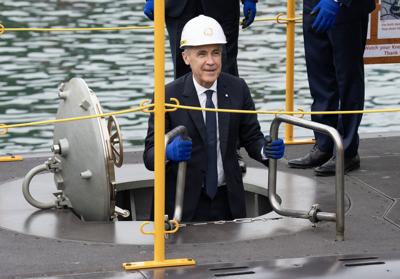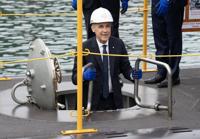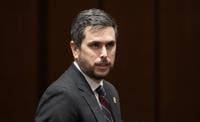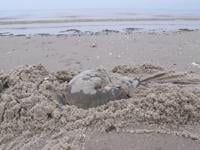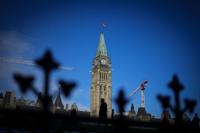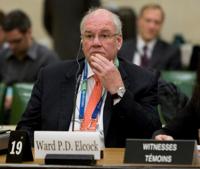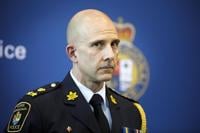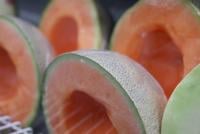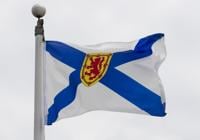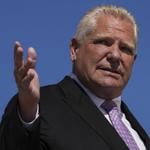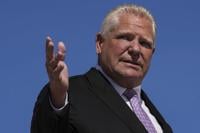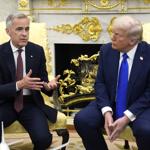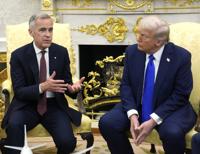GEOJE - Prime Minister Mark Carney toured a South Korean submarine Thursday during a visit to the shipyards of Hanwha Ocean, one of two companies competing to build Canada's next fleet of submarines.
On the same day that Canada and South Korea agreed to a new defence partnership, Carney was joined at the shipyard by Defence Minister David McGuinty, Vice-Admiral Angus Topshee and South Korean Prime Minister Kim Min-Seok.
"It's a beautiful submarine," said Topshee, commander of the Royal ºÚÁϳԹÏÍø Navy.
Hanwha officials showed off their production facility, which features automated welding by robots.
Canada plans to buy up to 12 new submarines to replace the navy's aging Victoria Class fleet, part of an effort to bolster the military's presence in the Arctic.
Carney toured a rival submarine facility in Kiel, Germany on Aug. 26, the day he announced the two finalist bidders: Hanwha and Germany's ThyssenKrupp Marine Systems, or TKMS.
The four Victoria Class subs will be out of commission within a decade and only one is currently in working order, putting the government in a race against time to select a winner.
Topshee said a decision in the next year "would be fantastic."
"Both submarines are excellent submarines and meet the requirements that we have," he said.
David Perry, president of the ºÚÁϳԹÏÍø Global Affairs Institute, said that, compared to most defence procurements, the submarine project is "moving at light speed" and the competition for the multi-billion dollar contract is heated.
Choosing a winner will also factor into Canada's industrial and trade strategies, since both bidders and their home countries are competing fiercely behind the scenes to offer spinoff economic benefits to Canada.
McGuinty said Hanwha is "a very serious company."Â
He gave no deadline for making a decision. He said the factors influencing that decision include the delivery timeline, whether the bidders will use ºÚÁϳԹÏÍø inputs like steel and aluminum, and how the promised industrial benefits stack up.
Perry said awarding this contract would be "among the most actionable things the prime minister can do to actually achieve some of that trade diversification he's been talking about."
"The government of Canada can negotiate trade agreements, support trade access by having the trade commissioner service support businesses' activities, but the government doesn't actually trade directly, so Carney's leverage in that respect is limited," he said.
"Purchasing a new submarine — that's a lever he can pull on himself."
Hanwha has talked about investing in ºÚÁϳԹÏÍø lithium-ion battery production, liquefied natural gas, aerospace, steel and critical minerals, and is offering to build two submarine sustainment facilities on both coasts.
Hanwha is a vertically integrated conglomerate that bills itself as South Korea's seventh-largest business group, and is aggressively pursuing a global expansion strategy.
The company maintains that if Canada signs a contract next year, it can leverage its massive shipyard capacity to beat any rival's delivery schedule.
It says it can build four KSS-III submarines by 2035, with the first to be delivered in 2032. It says that after the first four are delivered, it can send Canada a new one every year.
Steve Jeong, Hanwha's head of naval ship global business development, said Hanwha could build subs in Canada but that might take another 10 to 12 years.
"I'd rather build it here because we can provide submarine more quickly for ºÚÁϳԹÏÍø navy," he said.
The company claims early delivery could allow Canada to avoid $1 billion on repairs by retiring the Victoria subs early. Hanwha says the 12 subs would cost in the ballpark of $20-24 billion, which does not include the infrastructure to service them.
Hanwha's KSS-III — a bigger boat than its German rival — uses lithium-ion batteries and comes with vertical launch tubes that allow the subs to fire ballistic missiles straight up into the air. The South Korean navy is currently operating the sub but it has not been exported yet.
South Korea is eager to grow its domestic defence industry and has pushed hard to expand exports and move itself away from overreliance on the U.S. Korea was the eighth-largest arms exporter in the world in 2023 and wants to become the fourth-largest by 2027, according to an internal ºÚÁϳԹÏÍø Defence document.
Carney and South Korean President Lee Jae-Myung signed the defence partnership agreement earlier on Thursday. The deal will see more frequent joint exercises and training. It also commits the two nations to improving interoperability and exchanging military personnel, equipment and supplies.
"Ultimately we need to make sure that we are engaged more fulsomely in this region and we've chosen Korea for a reason," McGuinty said.
The South Koreans are pitching the submarine contract as the start of a wider industrial partnership between the two countries. Representatives from the embassy in Ottawa noted at an event last week that South Korea is now the second-largest supplier of military equipment to NATO countries, behind the United States.
Germany and Norway have together ordered a dozen of TKMS's 212CD submarines — a design so new that no navy has it in the water yet.
TKMS says it can beat Canada’s tight 2035 deadline for its first sub delivery, but its delivery schedule cannot meet the aggressive pace Hanwha is offering.
TKMS company brass and defence ministers from Germany and Norway travelled to Ottawa last week on a charm offensive ahead of Carney's trip to South Korea. They were trying to sell the ºÚÁϳԹÏÍø government on joining a club of nations operating the same subs that would allow the pooling of resources and parts.
The German defence firm is also telling Ottawa that it's a less risky bet. One of the world's oldest sub builders, TKMS has supplied some 70 per cent of NATO’s conventional sub fleet.
This report by ºÚÁϳԹÏÍø was first published Oct. 30, 2025.
— With files from Kyle Duggan in Ottawa

